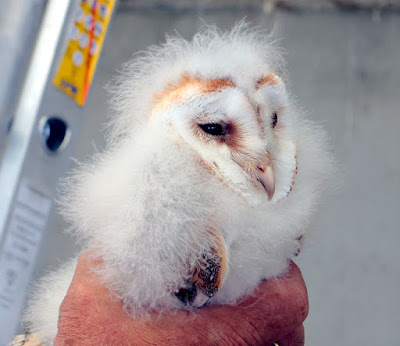The regular Barn Owl wasn't too obliging this morning. It spent the whole time dashing across and around several fields, hunting on the wing without taking a breather whereby I might picture it at rest. Barn Owls seem to do that at times - whizz around in an almost random and unpredictable fashion rather than a logical steady and measured search of the available ground. And then on the very next occasion you go the same bird will spend ages just sat around, moving occasionally from pillar to post and using the “watch, wait and pounce” method.
I've never quite worked out why the techniques are so different and how they relate to prevailing weather conditions, prey availability, the degree of urgency to find food, or the layout and the irregularity of the habitat which owls hunt.
Barn Owl
I had a few hours in which to check Conder Green. A surprise awaited in the form of a pair of Avocets with four brand new chicks. This was something of a shock because the family were on the marsh, running through the tidal creek, and not on the pool where everyone expects to see this year’s brood.
Avocets
So the Avocets have shown the resident Redshanks and Oystercatchers how to beat the system in what apart from a few pairs of terns and gulls has been a poor year for productivity. With mostly casual records rather than detailed study it’s hard to explain the poor year. The very low water levels with increased disturbance and interference from gulls, crows, ground predators and grazing sheep could be factors.
Otherwise, counts of waders and wildfowl included another pair of Avocet at the far end of the pool, 45 Redshank, 22 Oystercatcher, 5 Common Sandpiper, 1 Greenshank, 5 Little Egret, 1 Grey Heron, 1 Little Grebe and 2 Shelduck. At least two Shelduck have been present most of the season without any visible breeding success. Today gave a zero count of Tufted Duck, another species which so far, and now so late, failed to breed this year.
Avocet
The season saw successful but limited breeding courtesy of both Black-headed Gull and Common Terns on the floating pontoon with both species now feeding good sized young. The fact that these successes came via a relatively safe construction that is surrounded by water was perhaps a deciding factor. The pontoon is now only partially floating due to the drop in water level and may soon become a muddy island.
Common Tern
Little Egret
Small birds arrived in the form of 20 Sand Martin, 4 Reed Bunting 2 Whitethroat, 1 Reed Warbler and 1 Chiffchaff.
Just the other day came news of a Tawny Owl we ringed in 2011. It was caught at 0710 hours during an early morning autumn ringing session of 28 October 2011 at Rawcliffe Moss.
Tawny Owl GR26760 from 28/10/2011
Will and I aged it as an adult and fitted ring number GR26760. The morning was quite quite productive with 29 birds caught - 10 Chaffinch, 5 Reed Bunting, 4 Redwing, 4 Lesser Redpoll, 3 Goldfinch and one each Dunnock, Great Tit and the Tawny Owl.
On 29th June 2019, over seven and a half years later the owl was found “Sick, Wounded, Unhealthy” in the same location and taken into care by a raptor rescue team.
The typical lifespan of a Tawny Owl is five years, but an age of over 18 years has been recorded for a wild Tawny Owl, and of over 27 years for a captive bird.
I hope our Tawny survived its mishap and old age but so far I have not been able to check out the latest news. Stay tuned for an update.
UPDATE.
The owl had an eye infection, is now doing well and will be released in the next few days.
Linking today to Anni's Birding and Eileens's Saturday Blog.
UPDATE.
The owl had an eye infection, is now doing well and will be released in the next few days.
Linking today to Anni's Birding and Eileens's Saturday Blog.









































































